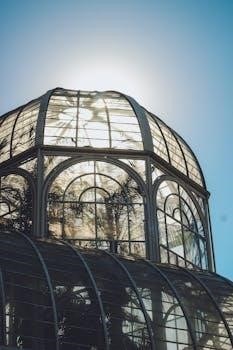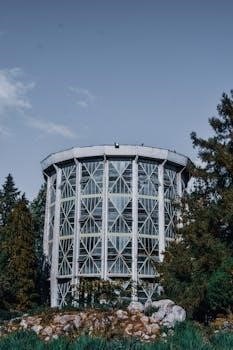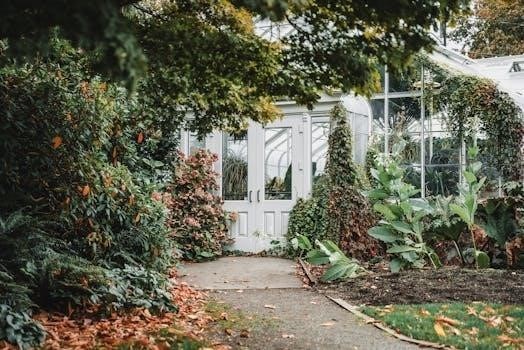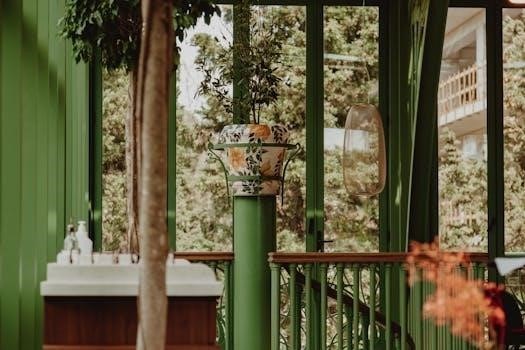cattle panel greenhouse plans pdf

Cattle panel greenhouses offer an affordable and effective method to extend the growing season. These structures utilize sturdy cattle panels, creating a versatile frame for various designs. Many find them ideal for climate control, providing warmth or shade as needed.
What is a Cattle Panel Greenhouse?
A cattle panel greenhouse is a DIY structure that uses large, metal mesh panels designed for livestock containment as its primary framework. These panels, typically 16 feet long and around 50 inches high, are bent into arched shapes to create the greenhouse’s roof and sides. This frame is then covered with plastic or other materials to trap heat and create a controlled growing environment, offering a cost-effective alternative to traditional greenhouses and allowing for extended growing seasons.
Advantages of Using Cattle Panels
Cattle panels offer significant advantages for greenhouse construction, providing a durable and cost-effective framework. Their robust nature ensures longevity, while their versatility allows for various designs. They are also relatively easy to work with.
Cost-Effectiveness
Cattle panel greenhouses are known for their affordability, making them an attractive option for budget-conscious gardeners. The panels themselves are relatively inexpensive compared to other greenhouse framing materials. This cost-effectiveness extends to the ease of construction, often requiring minimal additional materials and tools. The simplicity of the design also contributes to lower overall building expenses, allowing for a functional greenhouse without breaking the bank.
Durability and Longevity
Cattle panels are constructed from galvanized steel, ensuring exceptional durability and longevity for greenhouse structures. These panels are designed to withstand various weather conditions, including strong winds and heavy loads, providing a stable frame. With proper maintenance, cattle panel greenhouses can last for many years, making them a reliable and long-term investment for gardeners seeking a robust and enduring growing environment, especially compared to some alternatives.

Cattle Panel Dimensions and Greenhouse Size
Understanding cattle panel dimensions is key to planning your greenhouse. Standard panels are typically 16 feet long and about 50 inches tall. Greenhouse size depends on the number of panels used.
Standard Cattle Panel Size
Standard cattle panels generally measure 16 feet in length and approximately 50 inches in height, providing a consistent building block for greenhouse construction. These panels are constructed from 4-gauge galvanized wire, welded for strength and durability. The consistent size allows for easy planning and assembly, making them a popular choice for DIY greenhouse projects. Their dimensions help determine the overall footprint and height of the structure, impacting the growing space available.
Common Greenhouse Dimensions
While the cattle panels themselves are typically 16 feet long, common greenhouse dimensions vary based on design and space. A frequently used size is 8 feet wide by 12 feet long, often achieved by bending the panels to create an arched structure. Other popular configurations include 7 feet wide with varying lengths and sometimes even 10 feet by 32 feet for larger setups. The greenhouse height typically reaches around 6 feet in the center, providing ample room for plants.
Materials Needed for Construction
Building a cattle panel greenhouse requires a few key materials, such as cattle panels, framing wood, screws, and greenhouse plastic. Zip ties or metal brackets are needed for securing the panels.
Cattle Panels Quantity
The number of cattle panels needed depends on your desired greenhouse size. For a standard 8×12 foot structure, around four to six 16-foot panels are typically used. Larger greenhouses will require more panels; a 25-foot long greenhouse might need six. Consider that standard panels are about 50 inches high. The quantity will vary based on if you plan on having end walls constructed out of wood, or if you are going to use panels.
Framing Materials
While cattle panels form the main structure, framing materials add stability. Wood, such as 2x4s, is commonly used for end walls and door frames. Metal brackets and screws are essential for joining these elements. Some builds also incorporate rebar for ground anchoring. The type and quantity will depend on the desired design, size, and any additional support you might require to secure the structure against the elements.

Construction Steps
Building involves site preparation, which includes leveling and measuring the area. Next, you’ll attach the cattle panels using staples or zip ties. Framing end walls and doors comes after this, then, finally, you add the chosen cover.
Preparing the Site
Before constructing your cattle panel greenhouse, selecting the right location is crucial. Ensure the site receives ample sunlight throughout the day, avoiding shade from trees or buildings. Measure the area accurately, considering the cattle panel dimensions, and level the ground. This will provide a stable base and ensure the greenhouse sits evenly; Proper site preparation is essential for a sturdy, long-lasting structure, making the subsequent steps easier and more effective for your growing needs.
Attaching Cattle Panels
Once the site is prepared, securely attach the cattle panels to the frame, using methods like galvanized wire staples or heavy-duty zip ties. Ensure the panels are evenly spaced and firmly connected to the base structure, whether that includes wood or rebar posts. The goal is to create a robust framework. Overlap the panels if necessary for your desired shape or size. This creates a stable structure ready for covering material. Correctly securing the panels is crucial for the greenhouse’s integrity.
Covering Options
After constructing the frame, consider covering materials. Greenhouse plastic is a popular choice, often 6 mil thick and UV stabilized for longevity. Other options exist, but plastic provides good climate control.
Greenhouse Plastic
Greenhouse plastic, typically a 6 mil polyethylene film, is a common and cost-effective covering choice for cattle panel greenhouses. This material offers good light transmission, allowing plants to thrive, and helps to retain heat within the structure. It’s often UV stabilized, which protects it from sun damage and extends its lifespan. Securely attaching the plastic to the frame using strips and staples is crucial for its stability and performance against the elements, ensuring that the greenhouse maintains its desired environment.

Additional Considerations
When building, consider ventilation to regulate temperature and humidity, crucial for plant health. Securing the structure is also vital, especially in windy areas, to prevent damage. These factors ensure a stable and effective greenhouse.
Ventilation
Proper ventilation is crucial in a cattle panel greenhouse to regulate temperature and humidity, preventing overheating and fungal diseases. Options include installing vents near the roof or sides, creating airflow. Some DIYers utilize roll-up sides with plastic or insect netting for adjustable airflow. Good ventilation ensures the plants thrive by maintaining optimal growing conditions. Remember to also consider the weather in your area when choosing a ventilation method.
Securing the Structure
Securing a cattle panel greenhouse is essential for withstanding wind and weather. Options include driving rebar stakes into the ground and attaching the panels. Some builders use wooden frames for added stability, securing panels with screws or wire. Proper anchoring prevents the structure from shifting or collapsing. Consider the local weather when choosing securing methods to ensure longevity. Heavy-duty zip ties can also provide additional support when attaching panels together.
PDF Plans and Resources
PDF plans offer a convenient way to guide the construction of cattle panel greenhouses. These resources often include detailed instructions, material lists, and diagrams. These digital plans help ensure a successful DIY project.
Availability of PDF Plans
Numerous online resources provide PDF plans for cattle panel greenhouses, often at a low cost or even for free. These plans cater to various sizes and designs, from small backyard setups to larger structures. Many websites and forums dedicated to gardening and DIY projects offer these downloadable guides, making it easy to find a plan that suits individual needs and preferences. Some plans focus on specific framing techniques or materials.
What PDF Plans Usually Include
Typically, PDF plans for cattle panel greenhouses include detailed diagrams and measurements for the structure’s frame. They often specify the number of cattle panels required and the dimensions for the base. These plans also provide material lists, encompassing wood, fasteners, and covering options. Step-by-step instructions are usually present, guiding users through the construction process. Some plans may include tips for ventilation and securing the structure.
Cattle Panel Greenhouses in Various Climates
Cattle panel greenhouses are adaptable to different climates, offering benefits in both cold and warm regions. They can be used for season extension and climate control, proving versatile for diverse needs.
Use in Cold Climates
In colder zones, cattle panel greenhouses can provide a significant jumpstart to the growing season. Even a simple structure wrapped in poly can extend the harvest. Passive heating methods, like compost, can help maintain warmer temperatures, allowing herbs and other plants to survive winter conditions. These structures are beneficial for early crops of tomatoes and other climbers, maximizing the growing potential in challenging climates.
Use in Warm Climates
Cattle panel greenhouses are also useful in warm climates, where they can provide essential shade and protection from intense sun. The structures can help regulate temperature and prevent plants from overheating. They can be used to create artificial shade, and to take advantage of the insulating properties when covered. This allows for better control over the growing environment, ensuring healthier and more productive plants even during hotter months.

DIY Examples and Variations
Cattle panel greenhouses offer many possibilities for customization. Designs vary greatly in size, from small setups to larger structures. They can be tailored to specific gardening needs and available space using different materials.
Different Designs and Sizes
Cattle panel greenhouses come in a variety of designs, from simple hoop houses to more complex structures with framed end walls. Sizes can range from small 8×12 setups, ideal for beginners, to larger 10×32 configurations for more extensive gardening. The standard 16-foot length of cattle panels allows for flexible dimensions that can be adjusted based on individual needs and available space. Some designs incorporate raised sides for added height and stability.
Customization Options
Cattle panel greenhouses are highly customizable, allowing for various personal touches. Gardeners can adjust the height and width by overlapping or cutting panels. Adding wooden frames, like those made of 2x4s, can create end walls and doorways. Covering options can be tailored with different plastic films, or even rigid panels. Some choose to add extra support using rebar or utilize zip ties and metal brackets for securing the structure. These choices allow for unique, functional designs.
Maintenance and Long-Term Care
Cattle panels are known for their longevity, often lasting 10-15 years. However, the covering material may need replacement periodically. Regular checks will ensure the greenhouse’s continued functionality and stability.
Panel Longevity
Cattle panels are exceptionally durable, typically lasting for many years, often between 10 to 15, or even longer with proper care. Their galvanized steel construction resists rust and corrosion, contributing to their extended lifespan. Environmental conditions and maintenance practices can affect longevity, but generally, they are a long-lasting investment for your greenhouse structure. Regular inspections help ensure their structural integrity.
Covering Replacement
Greenhouse plastic, used as a covering, will need periodic replacement, unlike the panels themselves. The frequency of replacement depends on the quality of the plastic and the weather conditions. Typically, greenhouse plastic needs replacing every few years to maintain optimal light transmission and insulation. It’s a straightforward process that involves removing the old plastic and securing new sheeting to the frame with staples or clips.